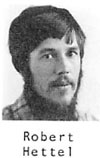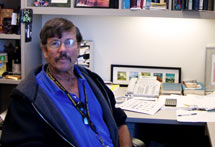
Handy Links
SLAC News Center
SLAC Today
- Subscribe
- Archives: Feb 2006-May 20, 2011
- Archives: May 23, 2011 and later
- Submit Feedback or Story Ideas
- About SLAC Today
SLAC News
Lab News
- Interactions
- Lightsources.org
- ILC NewsLine
- Int'l Science Grid This Week
- Fermilab Today
- Berkeley Lab News
- @brookhaven TODAY
- DOE Pulse
- CERN Courier
- DESY inForm
- US / LHC
SLAC Links
- Emergency
- Safety
- Policy Repository
- Site Entry Form

- Site Maps
- M & O Review
- Computing Status & Calendar
- SLAC Colloquium
- SLACspeak
- SLACspace
- SLAC Logo
- Café Menu
- Flea Market
- Web E-mail
- Marguerite Shuttle
- Discount Commuter Passes
-
Award Reporting Form
- SPIRES
- SciDoc
- Activity Groups
- Library
Stanford
Around the Bay
People: Bob Hettel's Teachers
Bob Hettel first visited SLAC on a high-school physics class field trip in 1966. As he and his classmates got off the bus at End Station A, SLAC's exuberant founding director "Pief" Panofsky was there to greet them and introduce them to the world of high-energy physics.
"That visit may have had more of an influence on my life than I imagined at the time," Hettel said.
Hettel is now the acting director for the Accelerator Directorate at SLAC. His days involve shaping the vision and strategy for the future of accelerator work at the lab as well as handling day-to-day personnel issues. "It's definitely a full spectrum job," he said. Hettel was deputy director before becoming acting director for the Accelerator Directorate. Previously, he represented the photon science program as Accelerator Division head at the Stanford Synchrotron Radiation Lightsource.
Hettel also holds the title of distinguished staff scientist, a distinction recently awarded to him by SLAC Director Persis Drell.
"I am a bit flabbergasted and humbled with this appointment," he said, explaining that his contributions and somewhat unconventional career path do not much resemble those normally associated with such a title. "Virtually all of my publications are in accelerator and instrumentation conference proceedings, not Science or Nature," he said. Hettel acknowledges that his present position is the result of the guidance and collaboration from many colleagues from all walks of life at SLAC.
"My teachers have been the multi-talented engineers, technicians, scientists, admins, managers and directors of this lab over the last 40 years," he said.

Hettel's career at SLAC began in the summer of 1967, when he participated in the Summer Science Program at Stanford, working in the Quantum Electronics Lab. "I spent the Summer of Love working on ring lasers with a couple of grad students," he said. During the summers of 1968 to 1971 he worked with then Electronics Department head Ray Larsen's staff on detector instrumentation, and ultimately on some early electronic controls for the new SPEAR storage ring, a machine with which he would become much more involved a decade later.
After graduating from Harvey Mudd College with a degree in physics, Hettel decided to leave academia to experience "the unknown." He spent two years traveling throughout Europe and North Africa and participating in volunteer work projects for the International Civil Service, returning to SLAC between trips to work in Larsen's department. Hettel came back to SLAC for good in 1980 to work at SSRL.
"That's when my more conventional career began," he said.
With SLAC physicist Herman Winick's encouragement he designed and built the first fast-orbit feedback system for lightsource photon beams, and began to learn about accelerator physics and technology, a migration he describes as one that "felt natural." When Helmut Wiedemann proposed building a dedicated injector for SSRL to take the place of the main linac, Hettel became the head of electrical, instrumentation and control systems, his first large-scale accelerator project.
SPEAR was operating as a dedicated photon source by the early 1990s and Hettel spent much of the ensuing decade working with the SSRL Accelerator Systems Department to optimize its performance. Before long, the staff realized that the incremental upgrades weren't matching the performance expectations of the lightsource community. Fortunately, Hettel said, the Department of Energy concluded that the SSRL science program was important enough to warrant a major upgrade to the ring, and he became the technical director of the SPEAR3 project. In 2003, shortly after SPEAR3 turned on, he took over as head of the SSRL Accelerator Systems Department.
Since then, Hettel has remained engaged in the future of lightsource concepts and technology. He has traveled to other labs as part of an advisory committee for new lightsources in the US, China and Europe, helping to broaden the scope of interest in lightsources based on the many things SLAC is doing with its accelerator technology. He is also part of the visionary team that proposed PEP-X, an ultra-low-emittance storage ring lightsource that will make use of the now decommissioned PEP-II facilities and, together with the LCLS, keep SLAC at the forefront of photon science.
—Lauren Rugani
SLAC Today, July 7, 2010
